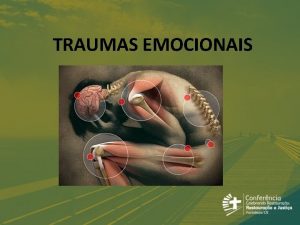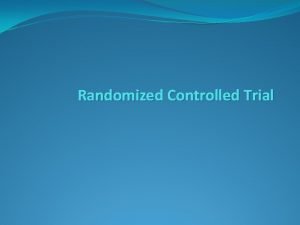Treating Children with Multiple Traumas A Randomized Controlled

- Slides: 1

Treating Children with Multiple Traumas – A Randomized Controlled Trial in Pragmatic Clinical Setting Kirsi Peltonen, Ph. D, & Samuli Kangaslampi, MA, University of Tampere, Finland Reasearch group website: https: //research. uta. fi/tasa-en/, Contact: kirsi. peltonen@uta. fi Introduction Exposure to multiple traumas during childhood is a major challenge for mental health throughout the lifespan. In particular, a strong association between violence-related traumatic events and posttraumatic symptoms has been established (Evans, Daivies, & Di. Lillo, 2008; Johnson & Thompson, 2008). Rates as high as 37% and 65% were found in very recent studies among refugee children and adolescents resettled into high-income countries (Buchmüller, Lembcke, Busch, Kumsta, & Leyendecker, 2018; Gandham, Gunasekera, Isaacs, Maycock, & Britton, 2017). At the same time, a great number of children living in high-income countries are exposed to family violence, and 13 -50% of them suffer from post traumatic stress disorder (PTSD) (Rossman, Hughes, & Rosenberg, 2000). This study includes children and adolescents exposed to violence either in war or refugeedom or within the family. Method Participants The sample consisted of 50 participants recruited among the patients and clients of the participating clinics. The participants were between 9 – 17 years of age, mean age 13. 2 (SD = 3. 2), who attended NET or TAU for posttraumatic stress symptoms. Boys made up slightly more than half (58%) of the sample. Three quarters of the participants were refugees or asylum seekers (n = 37) and one quarter were Finnish children and adolescents with experiences of family violence (n = 13). The refugee children and adolescents were from Iraq (n = 14), Afghanistan (n = 14) and various other countries (from other Middle Eastern countries and from African countries, n = 9). Randomization For traumatized children and adolescents in general, cognitivebehavioral therapy (CBT), especially its trauma-focused forms, has been repeatedly found to be effective in reducing PTSD and other mental health symptoms (Gillies, Taylor, Gray, O'Brien, & D'Abrew, 2012; Stallard, 2006). However, evidence with sophisticated designs in clinical settings among children is limited. Results ANOVA results indicated a significant main effect of time for PTSD Total score (F(1, 35) = 12. 93, p <. 001), as well as for the subscales of Intrusions (F(1, 35) = 21. 77, p < 0. 001) and Arousal (F(1, 35) = 8. 16, p =. 007), but not for Avoidance. The main effect of time was also significant for psychological distress reported by the child (F(1, 18) = 4. 97, p <. 039 and the guardian (F(1, 17) = 5. 94, p <. 026) as well as for resilience (F(1, 23) = 5. 14, p <. 033), but not for depression. The main effect of group and Time × Treatment interactions were not significant for any of the outcome variables. Intention-to-treat analyses employing linear mixed models confirmed these results. We conducted further within-group analyses for PTSD symptoms, as the interventions were specifically targeted to trauma. They showed that decrease in symptoms was significant for all PTSD symptom scales excluding Avoidance in NET, but not in the TAU group, and the effect sizes were large in NET, but small in TAU (NET: for PTSD Total score, t(20) = 3. 79, p <. 01, Cohen’s dz = 0. 83; for Intrusions, t(20) = 5. 17; p <. 001, dz = 1. 13; for Avoidance, t(20) = 1. 56, p =. 13, dz = 0. 34; Arousal t(20) = 2. 59; p =. 017, dz = 0. 57; TAU: for PTSD Total score, t(15) = 1. 46, p =. 164, Cohen’s dz = 0. 37; for Intrusions, t(15) = 1. 93, p =. 07, dz = 0. 48; for Avoidance, F(15) = 0. 052; p =. 96, dz = 0. 01; for Arousal, t(15) = 1. 53; p = 0. 148, dz = 0. 38). Narrative Exposure Therapy (NET) is based on CBT principles and its development has been influenced by exposure-based and testimonial therapies (Schauer, Neuner, & Elbert, 2011). It is a manualized, individual, short-term intervention program for the treatment of PTSD resulting from exposure to organized violence or other repeated traumatic events. When treating children and adolescents with multiple traumas, it might be important not only to tackle one event of their traumatic history, but to process all events that still cause PTSD symptoms (Mørkved et al. , 2014; Schauer et al. , 2011). The Current Study We seek to study the effectiveness of NET as part of every-day clinical work among multiply traumatized children by conducting a pragmatic clinical trial in the context of the existing healthcare system. In this study we ask: Does NET reduce a) posttraumatic stress disorder symptoms, b) depressive symptoms, or c) psychological distress, or improve d) resilience in children and adolescents with multiple traumas more effectively than TAU? We hypothesize that NET is more effective in reducing the symptoms and increasing the resilience than TAU. Figure 2. Mean levels of total PTSD symptoms, Intrusions, Avoidance and Arousal at pre- and post-test. Measures PTSD symptoms were measured by the Children's Revised Impact of Event Scale (CRIES; Horowitz, 1986; Smith, et al. , 2003). The reliabilities were: PTSD Total score: α =. 81 at T 1 and α =. 86 at T 3, Intrusions: α =. 64 at T 1 and α =. 83 at T 3, Avoidance: α =. 74 at T 1 and α =. 80 at T 3, Arousal: α =. 76 at T 1 and α =. 83 at T 3 Depressive symptoms were measured by the Depression Self-Rating Scale for Children (DSRS; Birleson et al. , 1987). The reliabilities were α =. 89 at T 1 and α =. 89 at T 3. Individual Resilience was measured by the questionnaire developed for this study, Reliability was α =. 89 at T 1 and α =. 75 at T 3. Psychological distress was measured by the Strengths and Difficulties Questionnaire (SDQ; Goodman, 1997). Reliability was α =. 82 for children’s self-reports and α =. 81 for parents’ reports at T 1 and α =. 76 for children’s self-reports and α =. 83 for parents’ reports at T 3. Discussion Despite the shortcomings of the current study, it gives preliminary support for the safety, effectiveness and usefulness of NET among multiply traumatized children and adolescents in clinical settings. Close attention must be paid to the implementation of the new intervention as an everyday tool in health care. We should aim to improve clinicians’ understanding of the safety and limited risks of exposure-based methods and diminish prejudices against such methods. Peer as well as supervisory support is needed when using the method with the first clients. Acknowledgements This project is funded by Academy of Finland.

